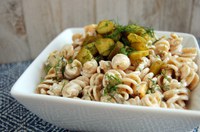Prairie Fare: Pick a Pickle
(Click an image below to view a high-resolution image that can be downloaded)
By Julie Garden-Robinson, Food and Nutrition Specialist
NDSU Extension
When I was growing up, a few food items always were in our refrigerator: milk, cheese, sandwich meat and a jar of some kind of homemade pickles.
Whenever guests dropped in, something pickled appeared in a fancy glass serving dish.
A piping hot casserole (hot dish) magically appeared in short order, too, along with sandwiches and a fresh dessert.
I still don’t know how this earlier generation of mothers (or maybe dads) had all this homemade food ready to heat and serve for visitors who casually popped by to visit. I guess those giant chest freezers in many basements were well-stocked.
Many homes also had cool, dark rooms devoted to storing home-canned goods made from the bounty of large gardens.
We had a “fruit room” in our basement with a variety of canned fruits and vegetables, including bread and butter pickles, watermelon rind pickles, sour dill pickles, sweet pickles and a few kinds of pickle relish.
When the holidays rolled around, we had pickled herring and pickled pigs feet purchased from a store. I donated my share of these pickled proteins to any family member who would eat them. They didn’t land on my plate.
I’m really not finicky, but I have my limits. My family seriously wanted me to eat “feet”?
Do you like pickles? You might like them on a hamburger or on a stick at a fair. You might enjoy pickle relish on a hotdog. Maybe a restaurant has brought you a plate of the trendy refrigerated “fresh vegetable pickles.”
Have you ever had battered, deep-fried pickle chips? Sample them if you have the opportunity at a restaurant. All foods can fit in a healthful diet in moderation, after all.
Pickling has a long history. Along with drying, pickling was one of the early forms of preserving food. Back then, people didn’t have refrigerators, freezers or any of the modern conveniences we have.
To eat during cold months, early people needed to figure out how to preserve food. They could dry vegetables or meat in the sun or over a fire. When you remove the moisture from food, most types of bacteria are not able to grow.
Others learned that putting food in a salty brine also preserved the food through fermentation by natural microorganisms.
I wasn’t around to observe this next part, nor were any food historians snapping pictures with their camera-phones. I suppose, back in time, someone’s batch of wine went “bad” and turned to vinegar. A kid might have dropped in his vegetables to avoid eating them. One person dared another to taste the food, and the person survived.
Or they fed it to an animal and the animal lived. Animal feeding behavior was an early guide to whether foods were edible.
Suddenly, they had portable food and we have sour-tasting crunchy foods that persist today. According to some food historians, pickling dates back thousands of years. Even ancient Egyptians enjoyed some types of pickled foods.
By definition, pickling is preserving a food such as a fruit, vegetable or protein that would spoil if it weren’t soaked in a salty or vinegary brine.
Bacteria, especially Clostridium botulinum, will not produce a toxin in an acidic environment. Eating a food containing the botulinum toxin can result in botulism, a potentially deadly form of foodborne illness. Pickled foods, therefore, were safe.
Pickles can be fermented in a salty brine, where naturally present lacto-bacteria produce lactic acid and the characteristic flavor and texture. Most pickles today are made using vinegar of a prescribed acidity level (5%).
You might have pickling recipes from your ancestry. Some heritage recipes meet today’s safety standards, while others do not. Be sure to compare heritage recipes to modern research-tested versions. If they are written in your grandma’s handwriting but do not meet today’s safety standards, frame the recipe but don’t make it.
Some of the vegetables and fruits we grow today are different chemically (less acidic, for example) than older varieties. The same recipe will not be safe.
With today’s research-tested recipes, you can pickle everything from crabapples to cantaloupe to pears safely. Try pickling some jars of peppers, or try making pickled carrots, green beans, mushrooms or asparagus.
Check out the NDSU Extension pickling guide available at https://www.ag.ndsu.edu/food in the food preservation section under “Pickle & Ferment.” A bushel of recipes are available from the National Center for Home Food Preservation and are linked from our website.
Remember these pickling rules from the U.S. Department of Agriculture, too:
- When making pickles, use canning salt, not table salt. Table salt will make the brine look cloudy.
- Do not alter vinegar, food or water proportions in a recipe or use a vinegar with unknown acidity.
- Use only recipes with tested proportions of ingredients.
- Follow the processing guidelines.
We periodically test recipes on campus, and this recipe is one of the recent ones. I was a little skeptical when I read the recipe, especially soaking the cooked pasta in pickle juice. However, it was so tasty that I looked for leftovers for an afternoon snack. This makes a side dish for burgers on the grill.
Dill Pickle Pasta Salad
8 ounces dry whole-wheat shell pasta (about 3 c.)
3/4 c. sliced pickles
2/3 c. cheddar cheese, cubed
3 Tbsp. white onion, finely diced (optional)
2 Tbsp. fresh dill
1/2 c. pickle juice
Dressing Ingredients
2/3 c. mayonnaise
1/3 c. Greek yogurt, plain
1/8 tsp. cayenne pepper (or to taste)
4 Tbsp. pickle juice
Salt and black pepper to taste
Cook pasta according to the package directions. Drain and rinse with cold water. Toss pasta with 1/2 cup pickle juice and set aside for five minutes. Combine all dressing ingredients in a small bowl and mix well. Drain pasta and discard any remaining pickle juice. Add pickles, cheese, onions and dill to pasta. Top with dressing and stir to combine. Chill for at least an hour before serving. Makes 16 (1/2 cup) servings. Each serving has 110 calories, 9 grams (g) fat, 3 g protein, 5 g carbohydrate, 0 g fiber and 150 milligrams sodium.
(Julie Garden-Robinson, Ph.D., R.D., L.R.D., is a North Dakota State University Extension food and nutrition specialist and professor in the Department of Health, Nutrition and Exercise Sciences. Follow her on Twitter @jgardenrobinson)
NDSU Agriculture Communication - Aug. 1, 2019
| Source: | Julie Garden-Robinson, 701-231-7187, julie.garden-robinson@ndsu.edu |
|---|---|
| Editor: | Ellen Crawford, 701-231-5391, ellen.crawford@ndsu.edu |



